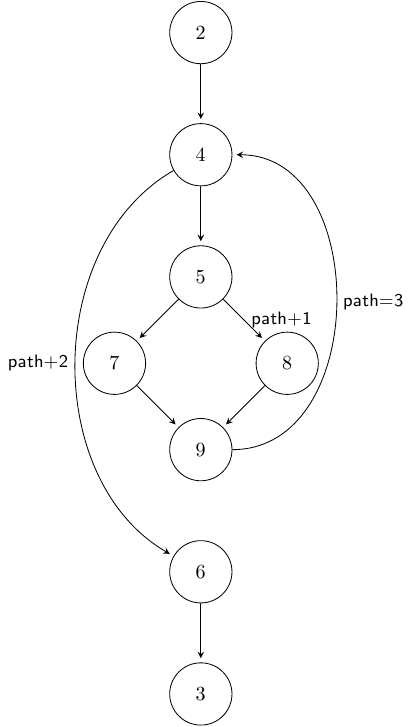CSI Guide
CSI Output: Metadata
Path Tracing Details
Path Tracing metadata is stored as text in the debug
section .debug_PT of the object file or executable. Note
that in the case of multiple object files linked into a single
executable, the executable contains the complete metadata consolidated
from all object files. To extract this data, use a command similar
to
Tools/extract-section --require .debug_PT myexe
The extracted information will contain entries for each instrumented function
in any object file linked into the executable. Each entry gives a
description of the control-flow graph of the function, augmented by line
number information and Ball/Larus instrumentation information (see
[4]). A complete example
(from the unit test loop) is:
#
rand
1|EXIT
0|ENTRY|5|5|5|5|5|5|5|5|-1|5
$
0->1|0$0
#
main
3|EXIT
2|ENTRY|9|9|9|9|9|9|9
4|10|10|10
5|11|11|12|12|12|12|13|13|13
6|-1|20|20|21|21
7|14
8|17
9|18|18|18|-1
$
2->4|0$0
4->5|0$0
4->6|2$2
5->7|0$0
5->8|1$1
6->3|0$0
7->9|0$0
8->9|0$0
9~>4|3$3
This metadata format obeys the following grammar. Non-terminals are distinguished from terminals by capitalization, color, and
italics.
| Function_List |
⩴ |
Function ↵ Function_List |
|
| |
ε |
| Function |
⩴ |
# ↵ fn-name ↵ Block_List ↵ $ ↵ Edge_List |
| Block_List |
⩴ |
Block ↵ Block_List |
|
| |
ε |
| Block |
⩴ |
block-id Block_Lines |
|
| |
block-id | ENTRY Block_Lines |
|
| |
block-id | EXIT |
|
| |
block-id | NULL |
| Block_Lines |
⩴ |
| line-num Block_Lines |
|
| |
| -1 Block_Lines |
|
| |
ε |
| Edge_List |
⩴ |
Edge ↵ Edge_List |
|
| |
ε |
| Edge |
⩴ |
block-id Arrow block-id | Increment $ Weight |
| Arrow |
⩴ |
-> |
|
| |
~> |
| Increment |
⩴ |
0 | 1 | … |
| Weight |
⩴ |
0 | 1 | … |
Each Function entry lists the function’s name,
line number information for the function’s basic blocks, and instrumentation
information for the control-flow graph edges (between basic blocks).
The function’s name is followed by N Block entries for the N basic blocks in the
function. Each block has a
block-id, which is unique within the function (though
not necessarily globally, though this is the case in the given example). This
id is followed by the list of line numbers for statements within that basic
block. The special value ENTRY preceeds this list of
Block_Lines for the unique function entry block.
The unique exit block is not allowed line numbers, and simply has the special
value EXIT. If the basic block has no statements with
line number information, the block has the special value
NULL. This is not an error, and occurs often in real
software both naturally and due to instrumentation requirements. If the list of
line numbers contains the sentinel value -1, this
basic block marks the completion of acyclic paths and writes the unqiue completed
path value into the tracing array.
The blocks are followed by a representation of the control-flow graph of the
function. Each Edge entry (from one source
block-id to the target
block-id) contains edge details and information
about instrumentation along the edge. If the arrow for the edge is straight
(->), the edge is a standard edge; if the arrow is
formed from a tilde (~>), it is a backedge. The
entry also contains the edge increment (for
instrumentation and partial path reconstruction) and the edge
weight (for complete acyclic path reconstruction). If
the edge is a backedge, these numbers represent the reinitialization of the path
sum. For details, see the papers
[2,
3], and the original
discussion of this instrumentation scheme in
[4].
In the example above, then, the basic block in function main
labeled 5 contains statements on lines 11, 12, and 13. It is not the end of
acyclic paths (it has no -1 in its line numbers), and has two outgoing edges.
One edge is to block 7 with an increment (and weight) of 0, and the other is to
block 8 with an increment (and weight) of 1. The entire graph thus looks
something like this:

